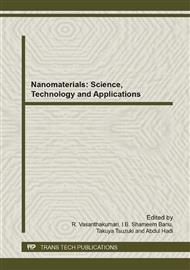[1]
Gregory G. Wildgoose, Craig E. Banks, Henry C. Leventis, and Richard G. Compton, Chemically Modified Carbon Nanotubes for Use in Electroanalysis, Microchim. Acta, 152 (2006) 187-214.
DOI: 10.1007/s00604-005-0449-x
Google Scholar
[2]
Gooding, J. J, Nanostructuring electrodes with carbon nanotubes: A review on electrochemistry and applications for sensing Electrochim. Acta, 50 (2005) 3049 -3060.
DOI: 10.1016/j.electacta.2004.08.052
Google Scholar
[3]
Lin Y, Yantasee W, Wang J, Carbon nanotubes (CNTs) for the development of electrochemical biosensors, J. Front. Biosci., 10 (2005) 492-505.
DOI: 10.2741/1545
Google Scholar
[4]
S. Iijima, Helical microtubes of graphitic carbon, Nature, 354 (1991) 56-58.
Google Scholar
[5]
R.H. Baughman, A.A. Zakhidov, W.A. de Heer, Carbon nanotubes-the route toward applications, Science, 297 (2002) 787-792.
DOI: 10.1126/science.1060928
Google Scholar
[6]
Robert J. Chen, Yuegang Zhang, Dunwei Wang, and Hongjie Dai, Noncovalent Sidewall Functionalization of Single-Walled Carbon Nanotubes for Protein Immobilization, J. Am. Chem. Soc., 123 (2001) 3838 - 3839.
DOI: 10.1021/ja010172b
Google Scholar
[7]
A. Merkoci, Carbon nanotubes in analytical sciences review, Microchim. Acta, 152 (2006) 157-174.
Google Scholar
[8]
J.J. Gooding, Nanostructuring electrodes with carbon nanotubes: a review on electrochemistry and applications for sensing, Electrochim. Acta, 50 (2005) 3049-3060.
DOI: 10.1016/j.electacta.2004.08.052
Google Scholar
[9]
A. Merkoci, M. Pumera, X. Llopis, B. Perez, M. del Valle, S. Alegret, Newmaterials for electrochemical sensing VI: carbon nanotube, Trends Anal. Chem., 24 (2005) 826 - 838.
DOI: 10.1016/j.trac.2005.03.019
Google Scholar
[10]
MacDiarmid, A. G. Synthetic Metals,: A Novel Role for Organic Polymers (Nobel Lecture) Copyright(c) The Nobel Foundation 2001. We thank the Nobel Foundation, Stockholm, for permission to print this lecture, Angew. Chem., Int. Ed., 40 (2001).
DOI: 10.1002/1521-3773(20020617)41:12<1998::aid-anie1998>3.0.co;2-8
Google Scholar
[11]
Heeger, A. J, Semiconducting and metallic polymers: the fourth generation of polymeric materials J. Phys. Chem. B, 105 (2001) 8475-8491.
DOI: 10.1021/jp011611w
Google Scholar
[12]
Hongying Liu, Guangfeng Wang, Daolei Chen, Wei Zhang, Chunjing Li, Bin Fang, Fabrication of polythionine/NPAu/MWNTs modified electrode for simultaneous determination of adenine and guanine in DNA, J. Electroanal. Chem., 595 (2006) 152-160.
DOI: 10.1016/j.snb.2007.06.028
Google Scholar
[13]
Umasankar Yogeswaran, Shen-Ming Chen, Multi-walled carbon nanotubes with poly(methylene blue) composite film for the enhancement and separation of electroanalytical responses of catecholamine and ascorbic acid, Sens. Actuators B, 130 (2008).
DOI: 10.1016/j.snb.2007.10.040
Google Scholar
[14]
Yan-Li Yao, Kwok-Keung Shiu, Low potential detection of glucose at carbon nanotube modified glassy carbon electrode with electropolymerized poly(toluidine blue O) film, Electrochim. Acta, 53 (2007) 278-284.
DOI: 10.1016/j.electacta.2007.04.007
Google Scholar
[15]
An amperometric hydrogen peroxide biosensor based on the immobilization of HRP on multi-walled carbon nanotubes/electro-copolymerized nano-Pt-poly(neutral red) composite membrane, Yuyong Zhang, Ruo Yuan, Yaqin Chai, Yun Xiang, Chenglin Hong, Xiaoqi Ran, Biochem. Eng. J., 51 (2010).
DOI: 10.1016/j.bej.2010.06.001
Google Scholar
[16]
F. Ricci, A. Amine, D. Moscone, G. Polleschi, Prussian Blue Modified Carbon Nanotube Paste Electrodes: A Comparative Study and a Biochemical Application, Anal. Lett., 36 (2003) 1921 - (1938).
DOI: 10.1081/al-120023622
Google Scholar


